Historic villages
NEWS ON HISTORICAL PLACES CROSSED BY THE ITINERARY OF THE SALENTO TRAIL
PALMARIGGI
Village located practically in the middle of the Maglie – Otranto route, whose name is linked to the prodigious event that took place according to tradition after the Otranto capture by the Turks. The inhabitants of the house of San Nicola invoked the protection of the Madonna who appeared holding a palm tree, and following an army. The Turks, fearing that the army led by duke Alfonso of Aragon was about to arrive, moved away and the population was saved. In memory of the event, the town changed its name to Palmarice, then Palmaricce and finally Palmariggi, which means “You who hold the palm“, in honor of the Madonna.
Palmariggi is home to an imposing Aragonese Castle built around 1480 following the capture of Otranto by the Turks, and was part of a vast strategic ring defense system, to protect Otranto itself, the capital of the province of the same name. It was Alfonso of Aragon who ordered the construction of the castle on the remains of the ancient Fortino di San Nicola, around which the village of Palmariggi would have formed around 1330. Only two mighty and massive cylindrical towers remain today of the structure, separated externally by a string course and joined together by a semi-ruined curtain wall.
Moreover, it is known for the festival that occurs every second weekend in October: «I paniri te e site» where the pomegranate and its exclusive uses are celebrated.
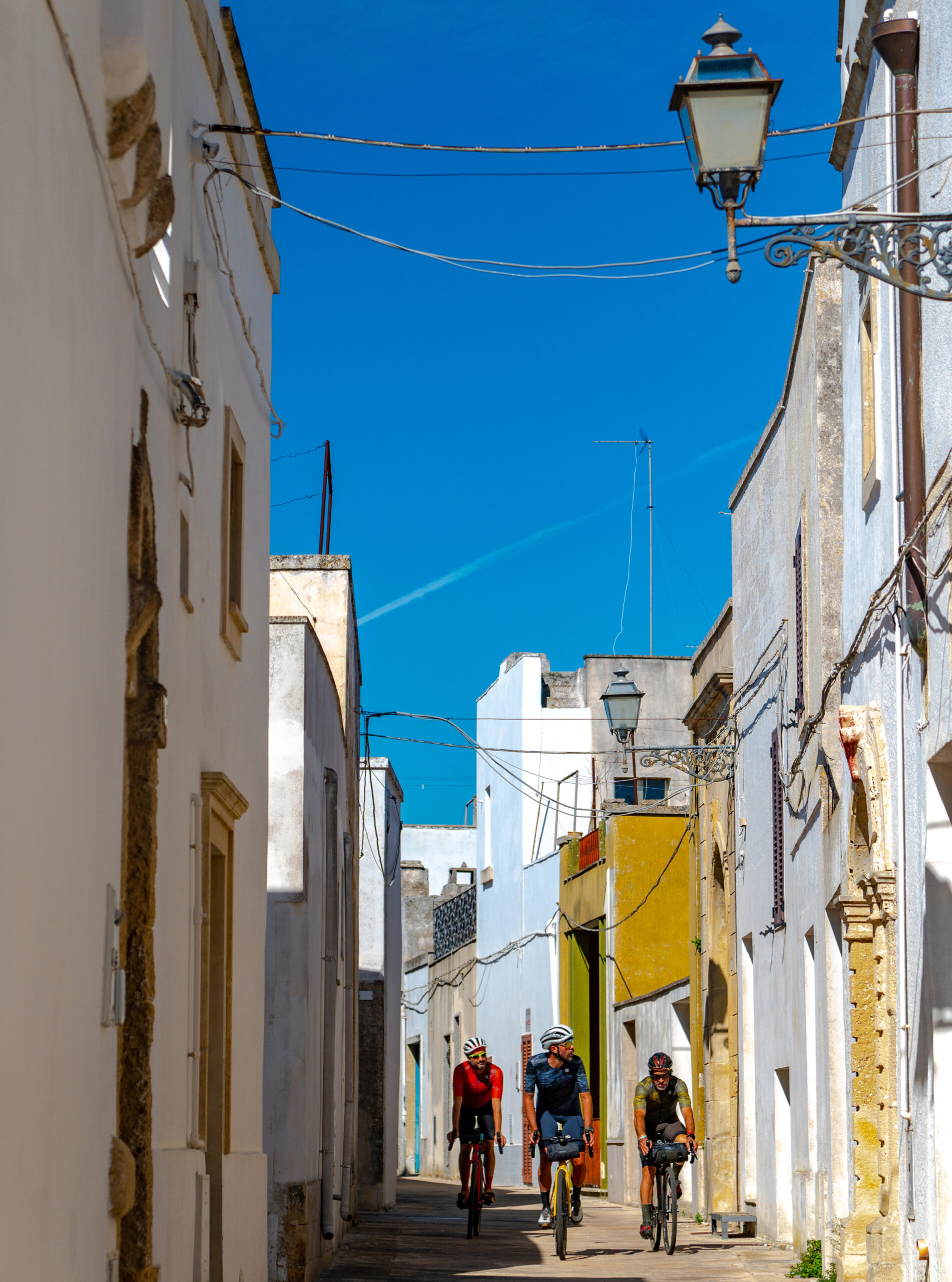
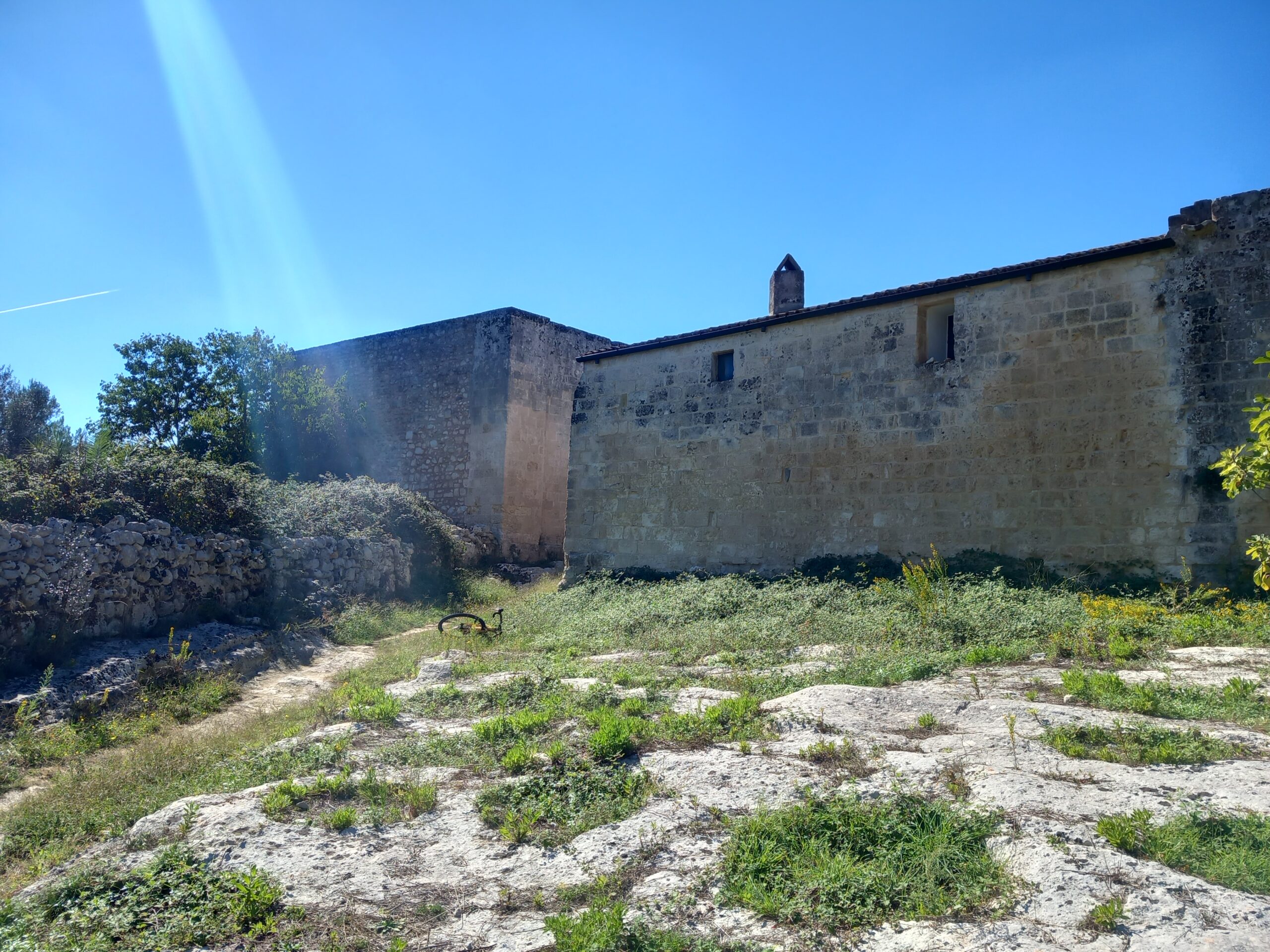
MASSERIA TORCITO
The Torcito-Cerceto farm in the 12th century was a large village inhabited by farmers dedicated to agriculture and sheep farming and then returned at the beginning of the 16th century, due to the growing danger of Turkish attack, in the coastal defense plan wanted by Carlo V by ordering and implementing the improvement of coastal defense systems. The Masseria di Torcito, resting on a slight plateau, a few kilometers from the sea, was highly exposed to the danger of Turkish attack, but at the same time constituted a good lookout point. But the history of the Torcito farmhouse is not only this but also that of its people who lived there and the time that marked its stones and you just need to take a walk between its walls and its carriageways to relive it.
TORRE DELL’ORSO
Torre dell’Orso is a seaside resort in Salento, marina of Melendugno.
Known for its beach of very fine silver-colored sand, Torre dell’Orso boasts a particularly clear sea due to the currents of the Otranto canal. The name of the locality derives from the presence, on the coast, of a 16th century tower used in the past to sight Turkish ships bound for Salento.
Torre dell’Orso is also known to most as the site of two stacks located about a hundred meters from the shore. Legend has it that two sisters, two local peasant women, one day approached the sea to cool off. One of the two entering the water is dragged away by the currents and gasps and screams for help: her sister can only throw herself to help her. In an attempt to reunite, they consume all their strength and embrace for the last time, now unable to overcome the fury of the sea, which swallows and drowns them.
However, the god of the sea is sorry, he has compassion for the two innocent sisters, one who died of unconsciousness and the other of brotherly love; so he transforms them into two stacks, close together for eternity.
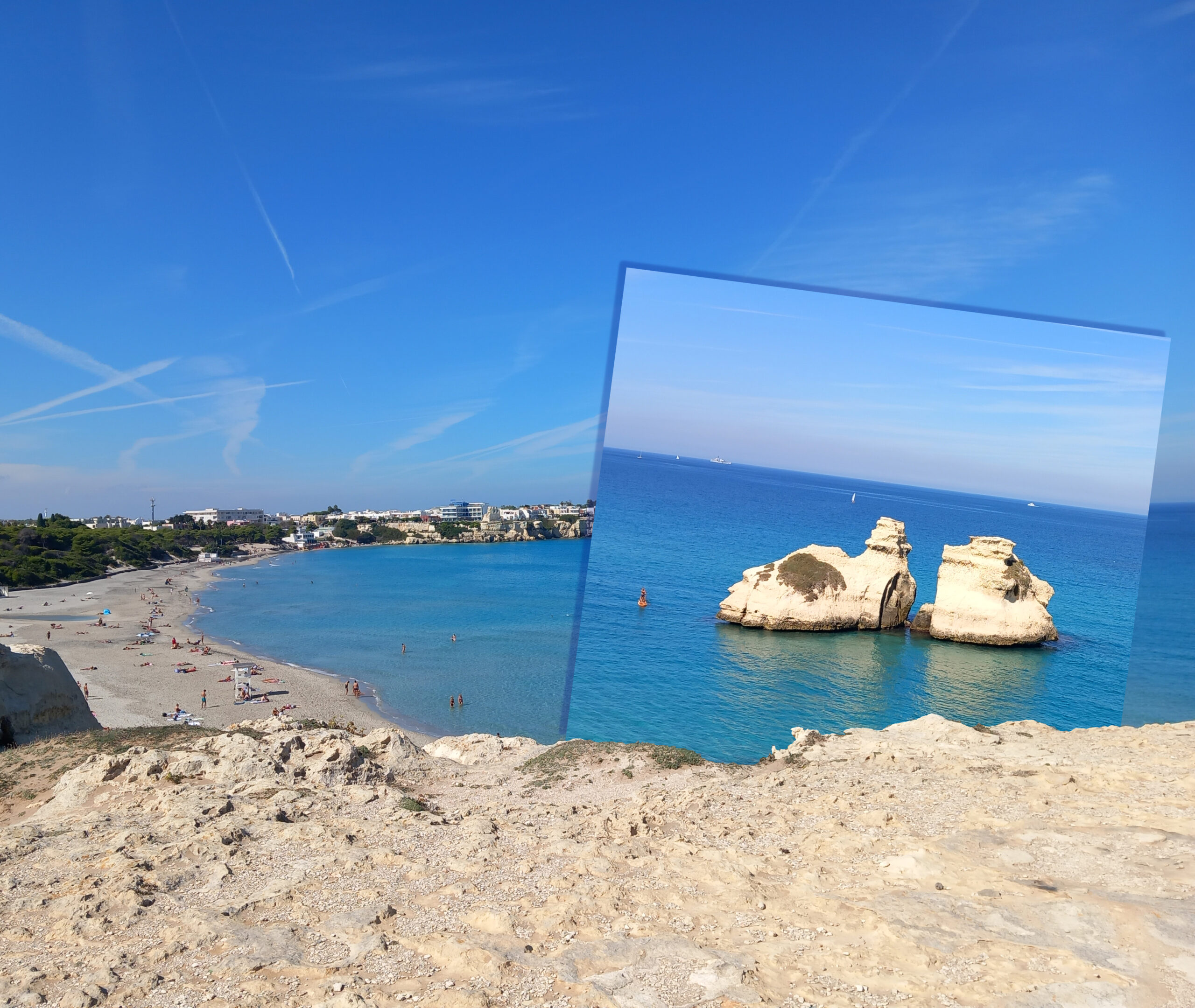
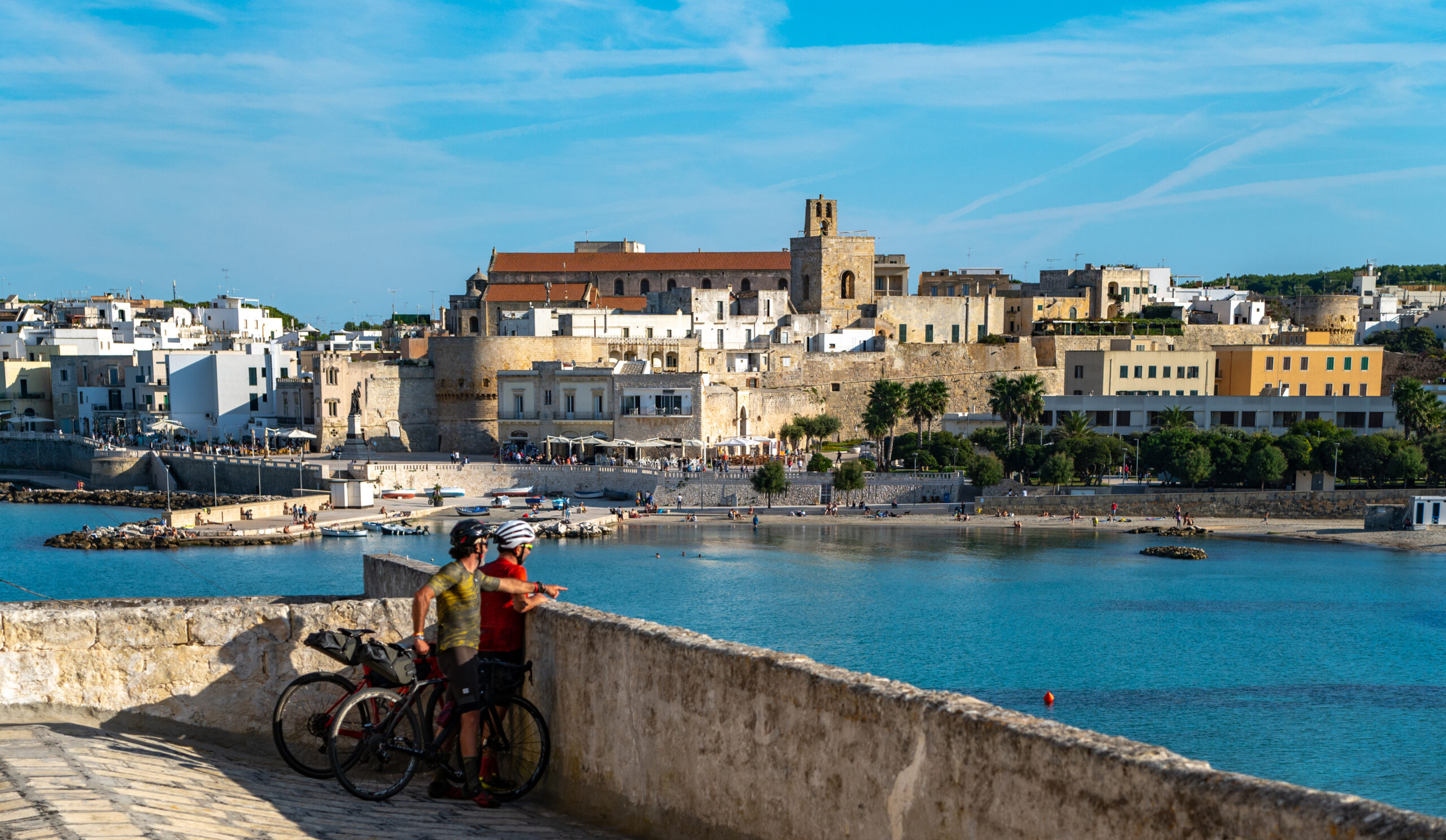
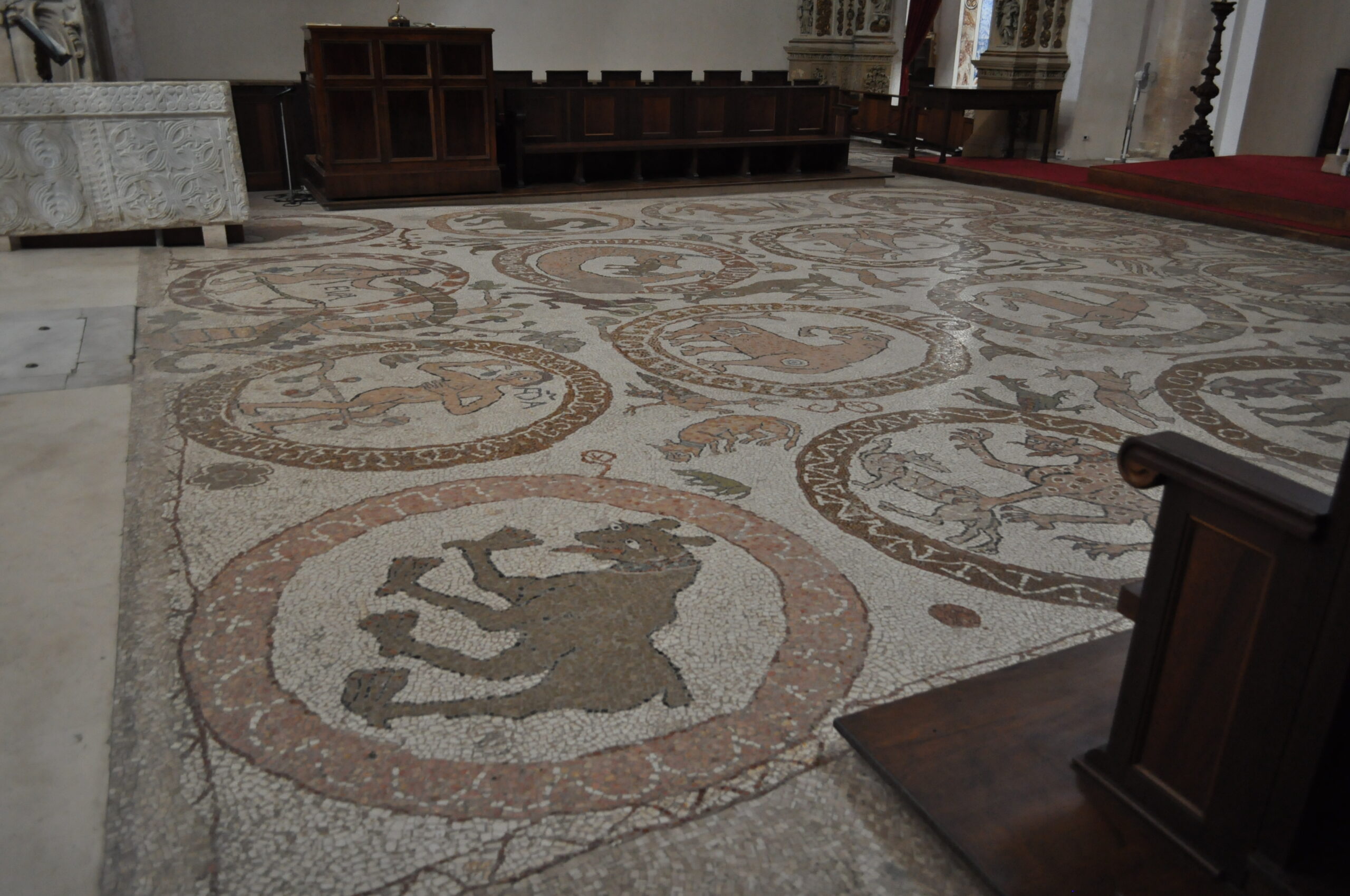
<s OTRANTO
The city of Otranto is the easternmost Italian municipality in Italy, it is now known internationally for tourism and accommodation thanks to its coasts and intense blue sea. Historically Otranto is also sadly famous for the Turkish occupation of 1480 and for the trail of blood they left there.
On July 28, 1480, 18,000 Ottomans, with a fleet of 150 ships, moved towards the Salento town with the intention of sacking and conquering it. After an exhausting resistance by the inhabitants of Otranto who did not want to surrender, the Turks took possession of the village, committing all sorts of cruelties. 800 brave men, now saints, after refusing to convert to Islam, were beheaded on the hill of Minerva.
The Saracens remained in the city for a year, until the Aragonese entered the town and liberated it. But Otranto now retained very little of its old charm. The abbey of Casole had been destroyed, as well as commerce and the Cathedral. A reconstruction was urgently needed and the Aragonese were immediately aware of it. They immediately set to work, putting the Cathedral and the walls back on their feet. The convents of the Dominicans, of San Francesco and of the observers were rebuilt and, at the end of the 14th century, that of the Capuchins.
Otranto is also home to the Cathedral mosaic floor that the monk Pantaleone, belonging to San Nicola di Casole, executed on commission from the Bishop of Otranto, between 1163 and the 1165. which represents one of the most important mosaic cycles of the Italian Middle Ages. An extraordinary and grandiose work, animated by a sense of horror vacui due to the compositional flair that runs through it, and has been compared to an encyclopedia of images of the time and culture of the Middle Ages. It does not seem to find equivalents, in terms of complexity and level of elaboration, with other contemporary mosaics.
BAUXITE LAKE – BAY OF ORTE
Near the baia delle Orte, located a few kilometers south of Otranto along the coast road that leads to Santa Maria di Leuca, there is a very characteristic and well-known lake, which it originates in a former bauxite quarry now abandoned, which has given the water an intense emerald colour, rich in shades of great beauty. We are also near the Punta Palascia lighthouse, a sign that we are in the easternmost point of all of Italy.
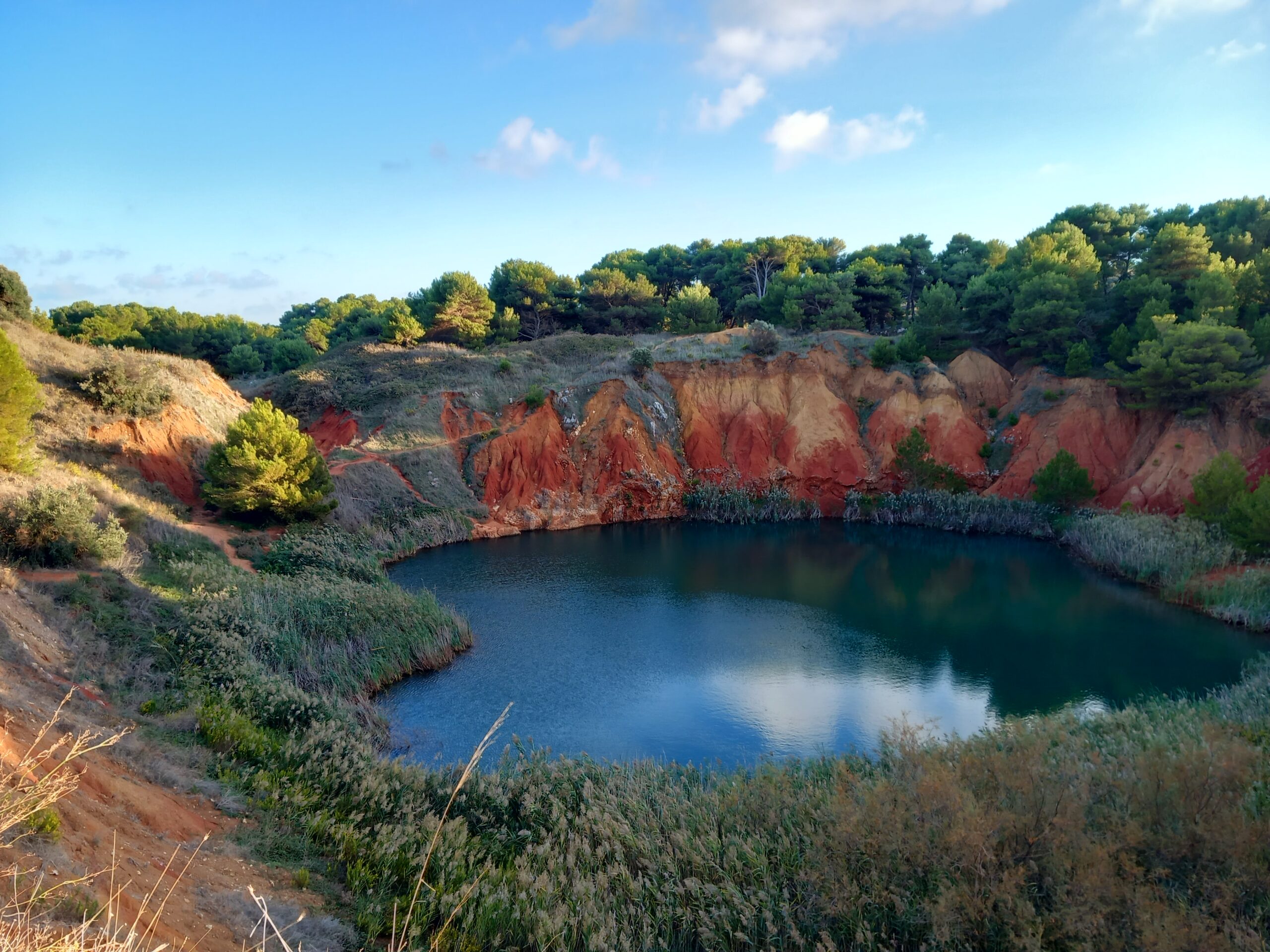
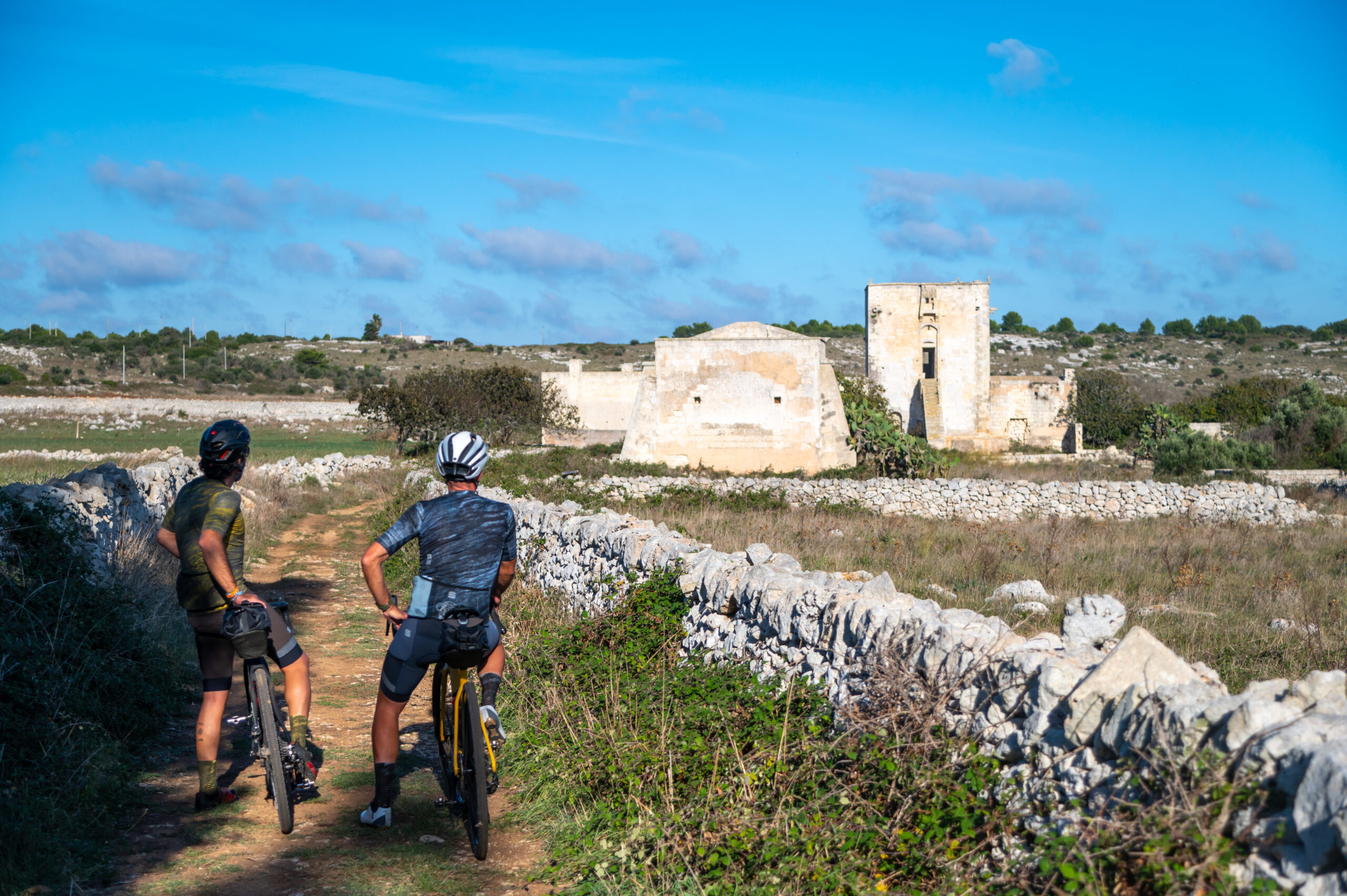
MASSERIA CIPPANO
Masseria Cippano became an integral part of that defensive system wanted by the then emperor of the Holy Roman Empire, Charles V, in direct communication with Torre Sant’Emiliano >, from which to receive and forward the danger message in the innermost areas of the hinterland.
Equipped with a tower (about 15 meters high) organized on two floors, enriched by a staircase with a drawbridge. A fortified structure equipped with machicolations, enclosed by rampart walls and supplied with water by a system of cisterns capable of collecting, filtering and transporting the precious liquid to the various rooms. A place of work and war, of life against the cruelty of the Turks. Ozpetek’s film Mine vaganti was filmed here.
PORTO BADISCO
Porto Badisco is a pearl of rare scenic beauty. A crystal clear sea invites you to swim in every month of the year and the bar «da Carlo» with its prominent square will not fail to cheer you up in the sunny hours. Following the coast road to the south, you come across Torre Minervino a Saracen tower These are the coastal towers, the legacy of a fortification plan commissioned by Charles V in the 16th century to defend the southern coasts from the bloody invasions of Turkish raiders who arrived from the sea. Indeed, from the sea came the danger to be averted with the cry of “mamma… the Turks“.
In Porto Badisco there is also the Grotta dei Cervi, which contains important drawings made with bat guano dating back to the Neolithic and is characterized by numerous ravines and coves of rare beauty. Furthermore, in the direction of Santa Cesarea-Castro-Leuca, there is the so-called “Grotta delle Striare“, i.e. cave of the witches, characterized by the entrance crossed diagonally by a tongue of rock.
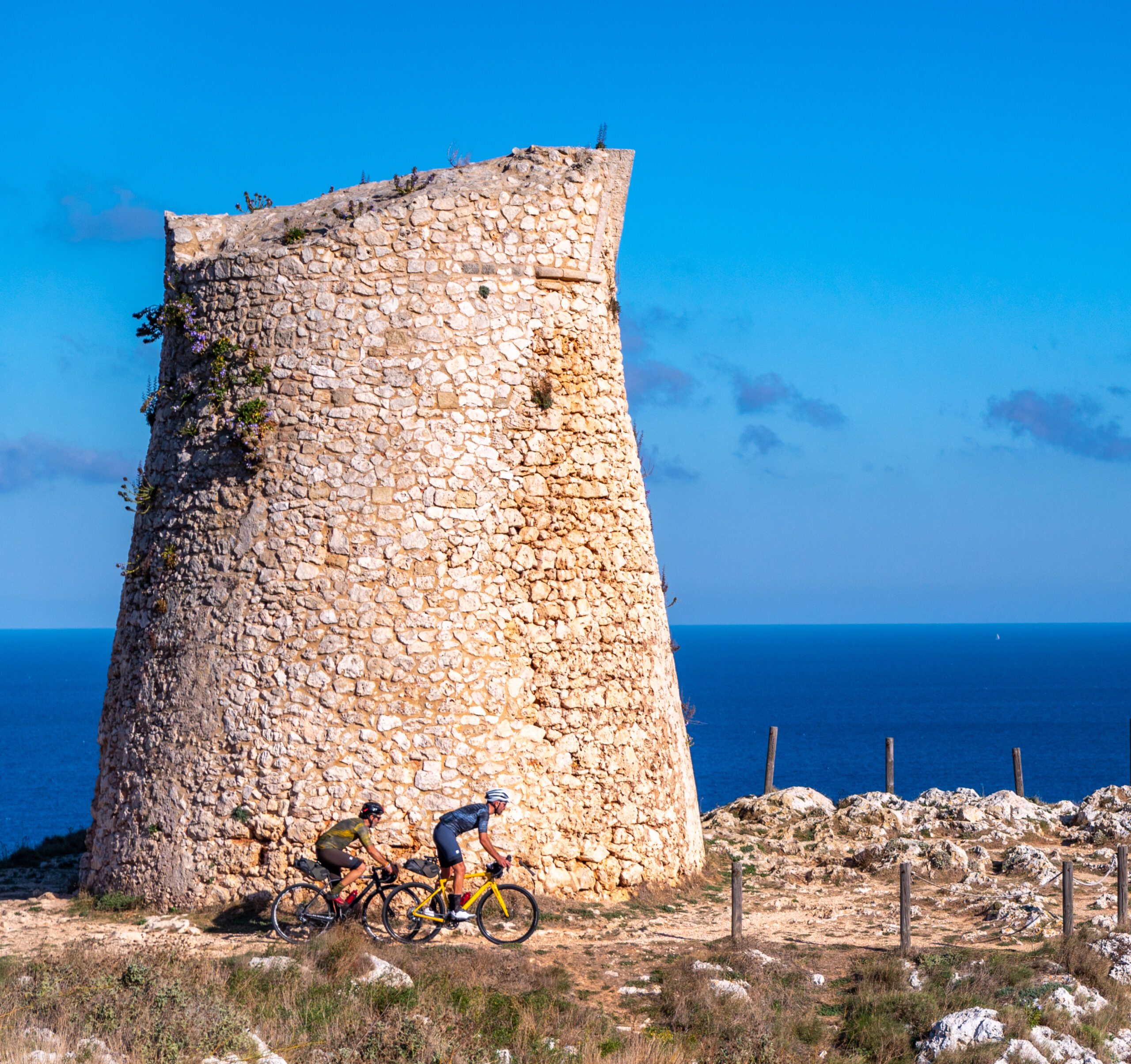
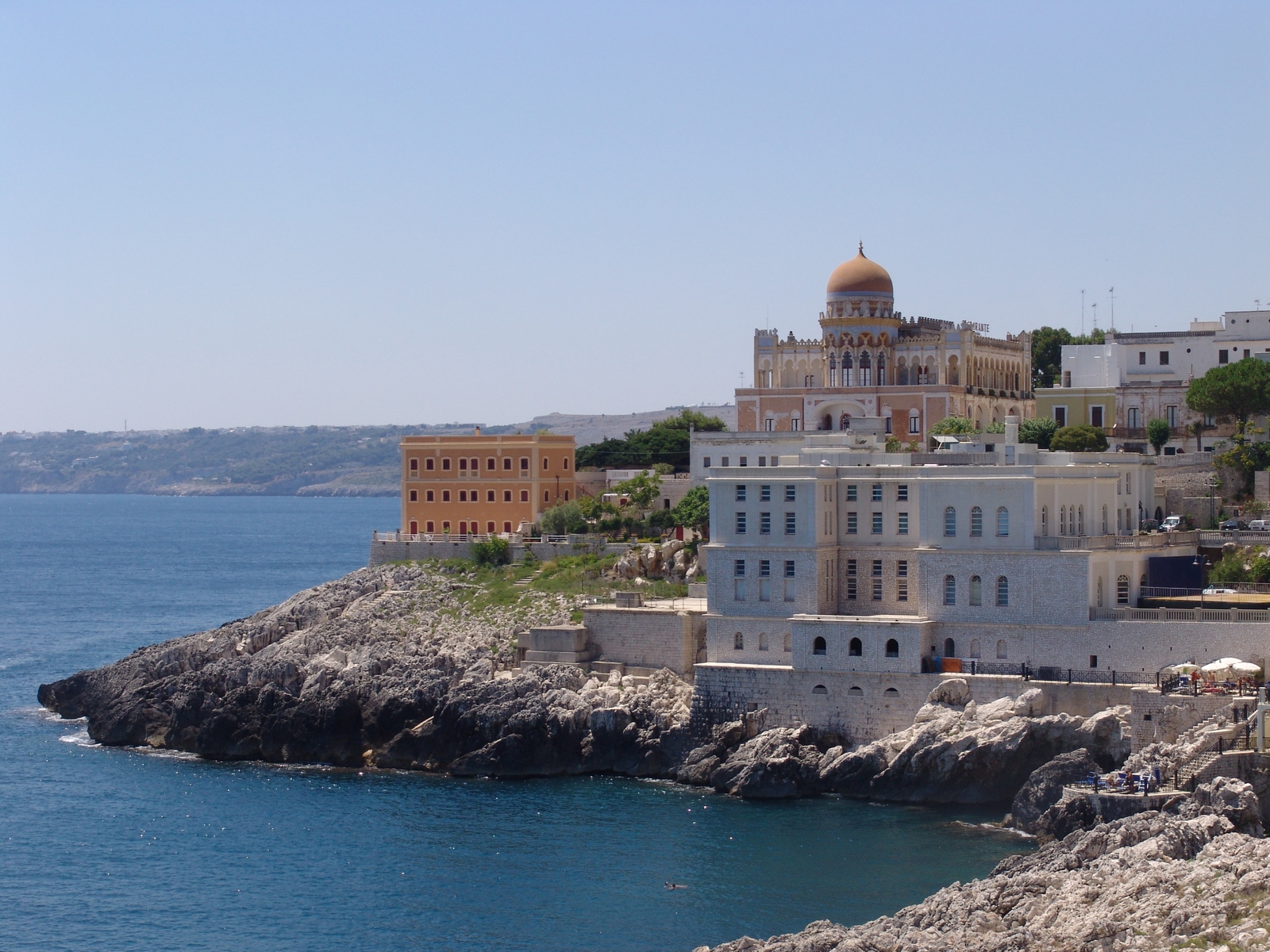
SANTA CESAREA TERME
Santa Cisaria in Salento dialect, until 1929 called Santa Cesarea is a municipality of 2,869 inhabitants. It is one of the centers with the greatest tourist vocation in Salento. It is a hydrothermal station. The exploitation of sulphurous waters and thermal mud dates back to the 2nd century BC. The healing waters flow from four caves: the Gattulla, the Solfatara, the Solfurea and the Fetida.
The pagan myth connects the genesis of the sulphurous waters to the disintegration of the bodies of the Leuterni giants, killed by Heracles. The Christian version instead wants Cesarea, or Cisaria, to be a girl with an early vocation to the monastic life. That to escape the repeated incestuous intentions of her father, she hid in a cave where she was saved from the flames that enveloped her father, then swallowed by the sea.
Santa Cesarea Terme is also known for the beauty of its Villas. Among these the Palazzo Sticchi and the Villa Raffaella
CASTRO
Castro is located along the eastern coast of the Salento peninsula, the municipality is made up of the main town of medieval origin, located on a promontory at 98 m above sea level. (Casciu de susu), and from the lower part of Castro Marina (Casciu de sutta), built around the port. Fishing and seaside resort, it boasts ancient origins as the heir of the Roman Castrum Minervae. Castro as well as for its splendid sea (characterized by a high quantity of fresh water springs) is also known for its splendid Aragonese Castle, considered one of the most important castles in all of Puglia.
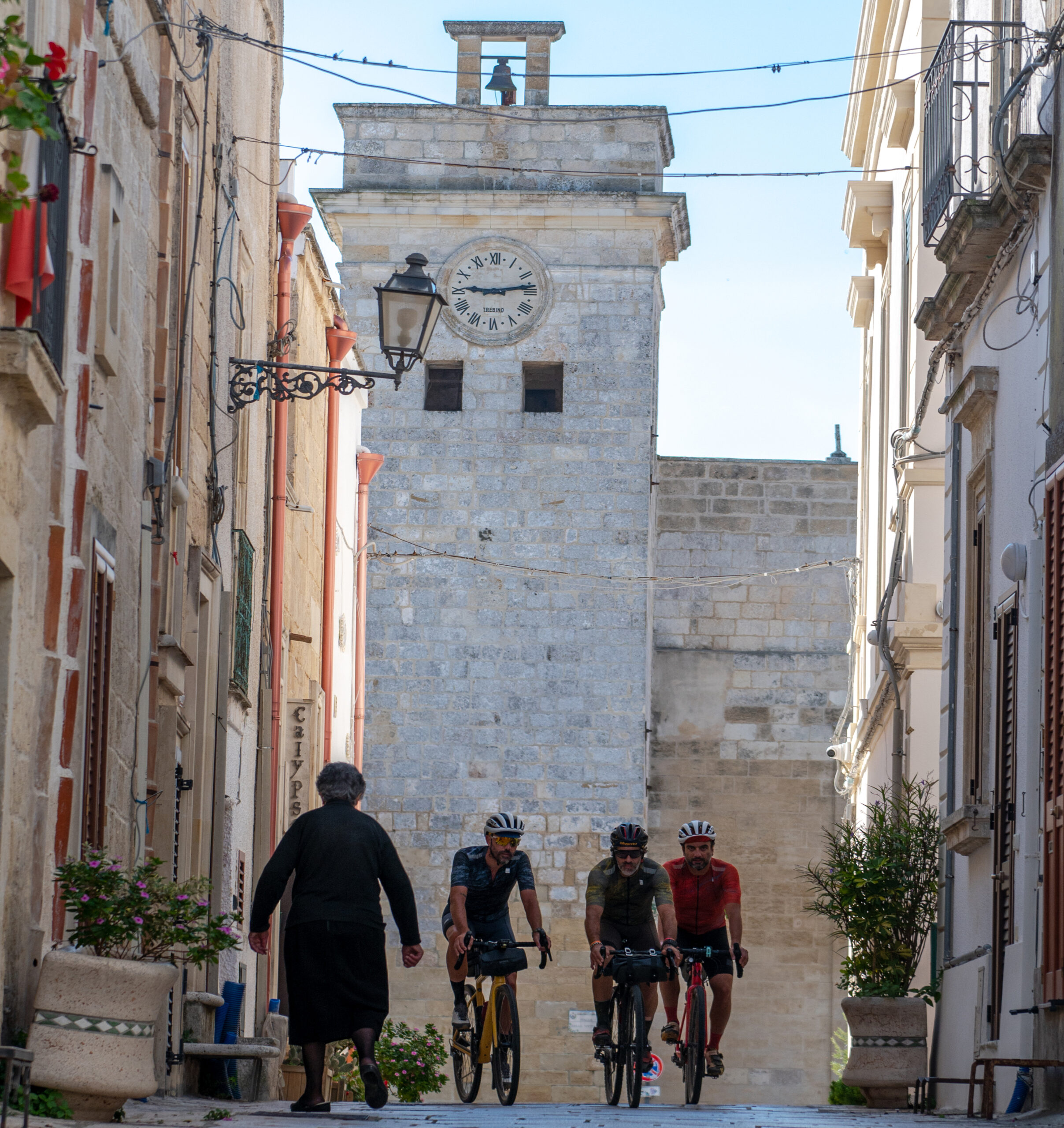
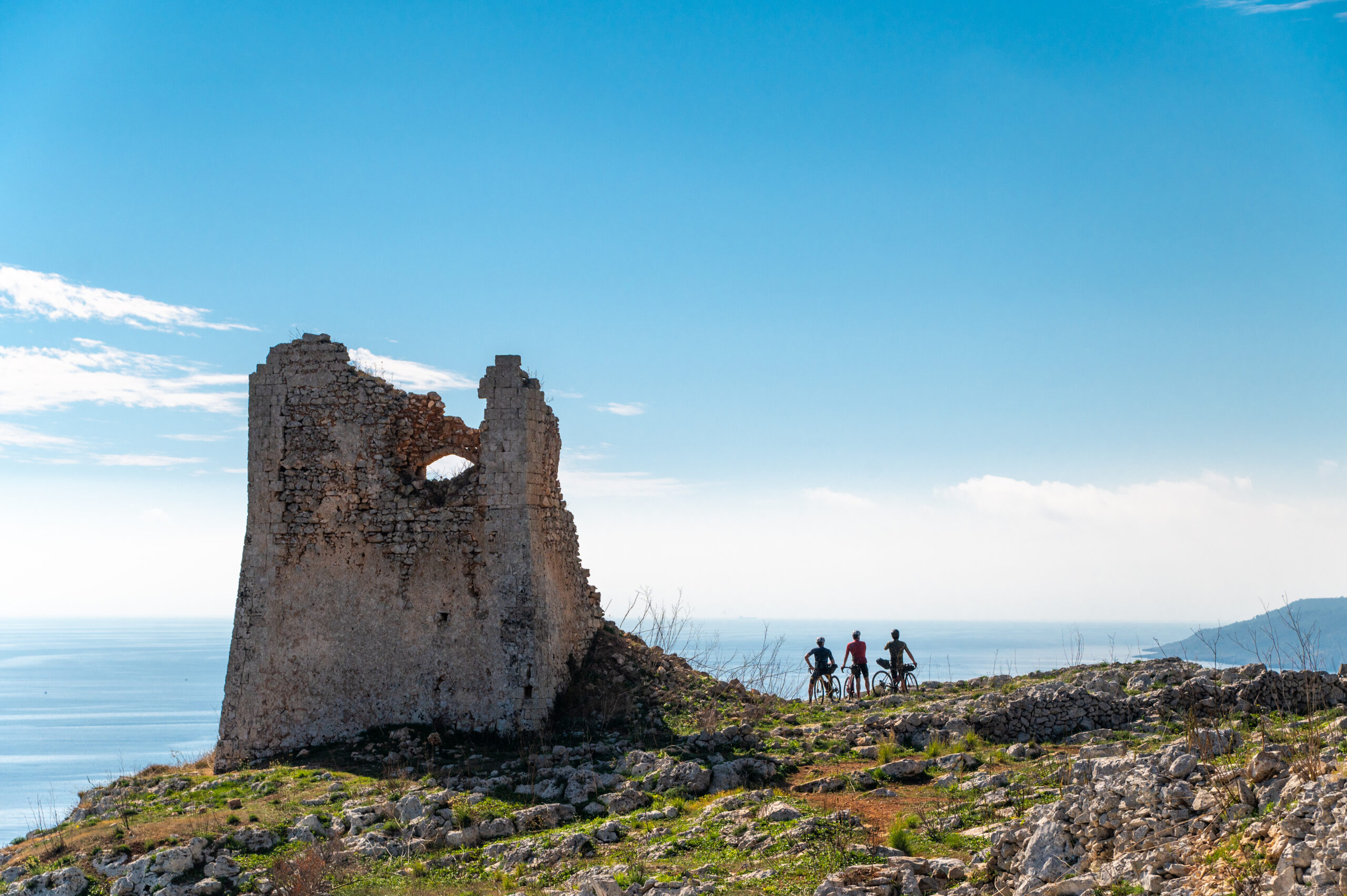
TRICASE AND THE SERRA DEL MITO
The origin of the name is still uncertain and the subject of studies and research. There are those who attribute its origin to the union of three different farmhouses which, by uniting, would have given rise to a single residential nucleus. Another more accredited theory translates its name as inter casas, that is to say, a town formed in the midst of other hamlets. But there are also those who attribute to it an entymology deriving from the Greek and therefore thesis, tracing its genesis back to Demetrios Tricás, a young official of the Eastern Roman Empire, in charge to monitor the situation of Capo di Leuca.
Among the noteworthy natural and historical architectural beauties, the following certainly stand out: The Palazzo Gallone, The Vallone Oak, dating back more than 900 years ago and the Torre del Sasso , ancient remains of a coastal defense system against Saracen attacks.
SANCTUARY OF SANTA MARIA DI LEUCA “de finibus terrae“
The church stands on the ruins of a pagan temple dedicated to Minerva, as evidenced by the discovery of an altar, kept inside the church, on which was written: “Ubi olim Minervae sacrificea offerebantur hodie oblationes Deiparae recipiuntur ” (Here where sacrifices and gifts are offered to Minerva, sacred offering to Maria Cristian you place)
Following the landing of the apostle Peter, of which the stone cross remains, the local population converted to Christianity. The church boasted a painting of the Virgin which was believed to be the work of San Luca which however was lost in its destruction following the edict of Diocletian and Galerius. Pope Julius I a few years later ordered its reconstruction anyway (the year was 343 as reported on a plaque: «Julius hic primus celebrans, emmissa de coelo Indulta accepit. Kalendas, CCCXLIII dum Consecravit hoc templum”
Over the years the church was repeatedly destroyed or looted by the Saracens and the Turks, the various nefarious events are dated in 1507, 1537, 1550, 1624 and 1720, but it was always rebuilt and fortified. During John Paul II’s visit in 1990, it was raised to a minor basilica, while another papal visit took place in 2008 with Benedict XVI.
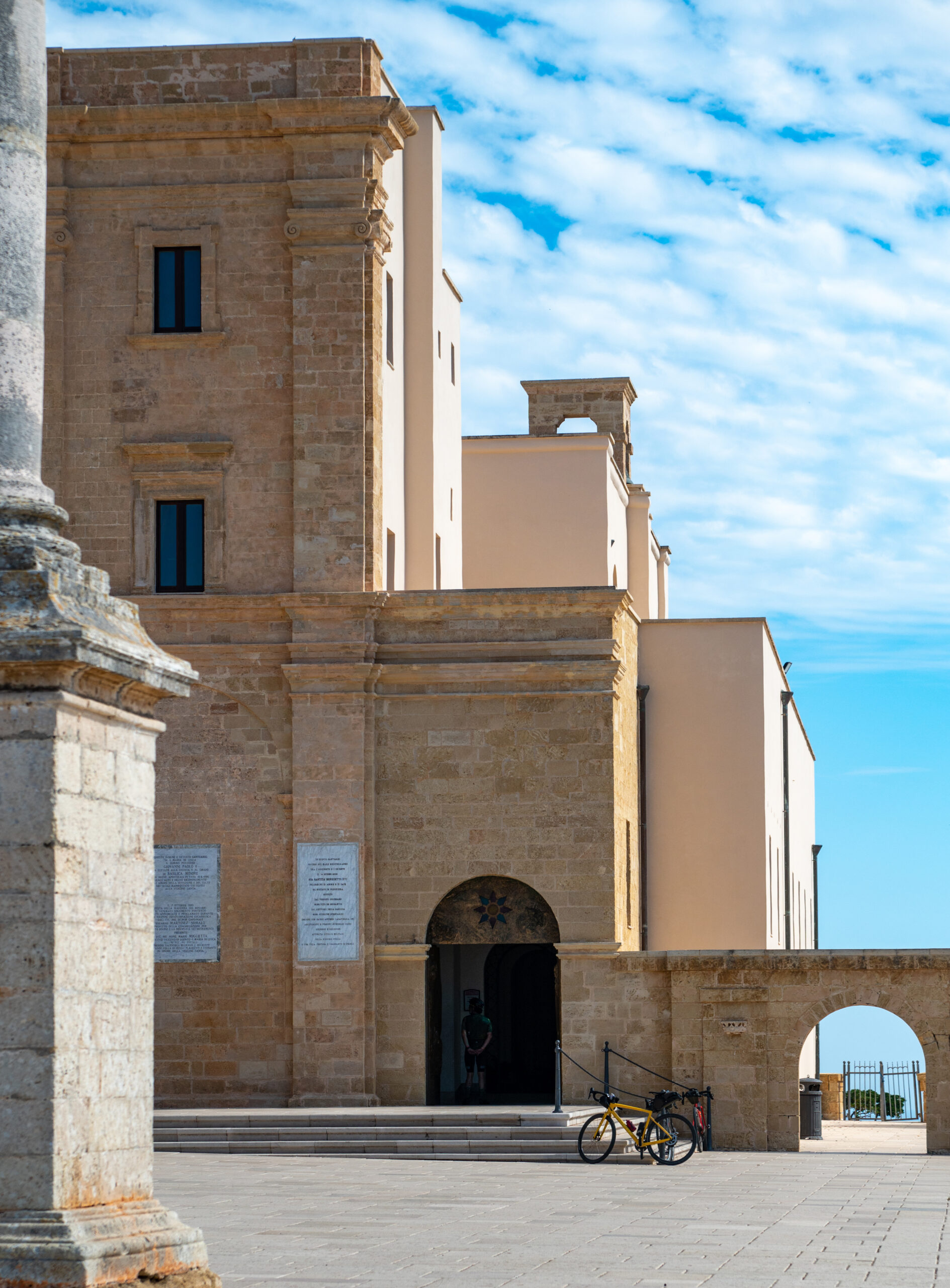
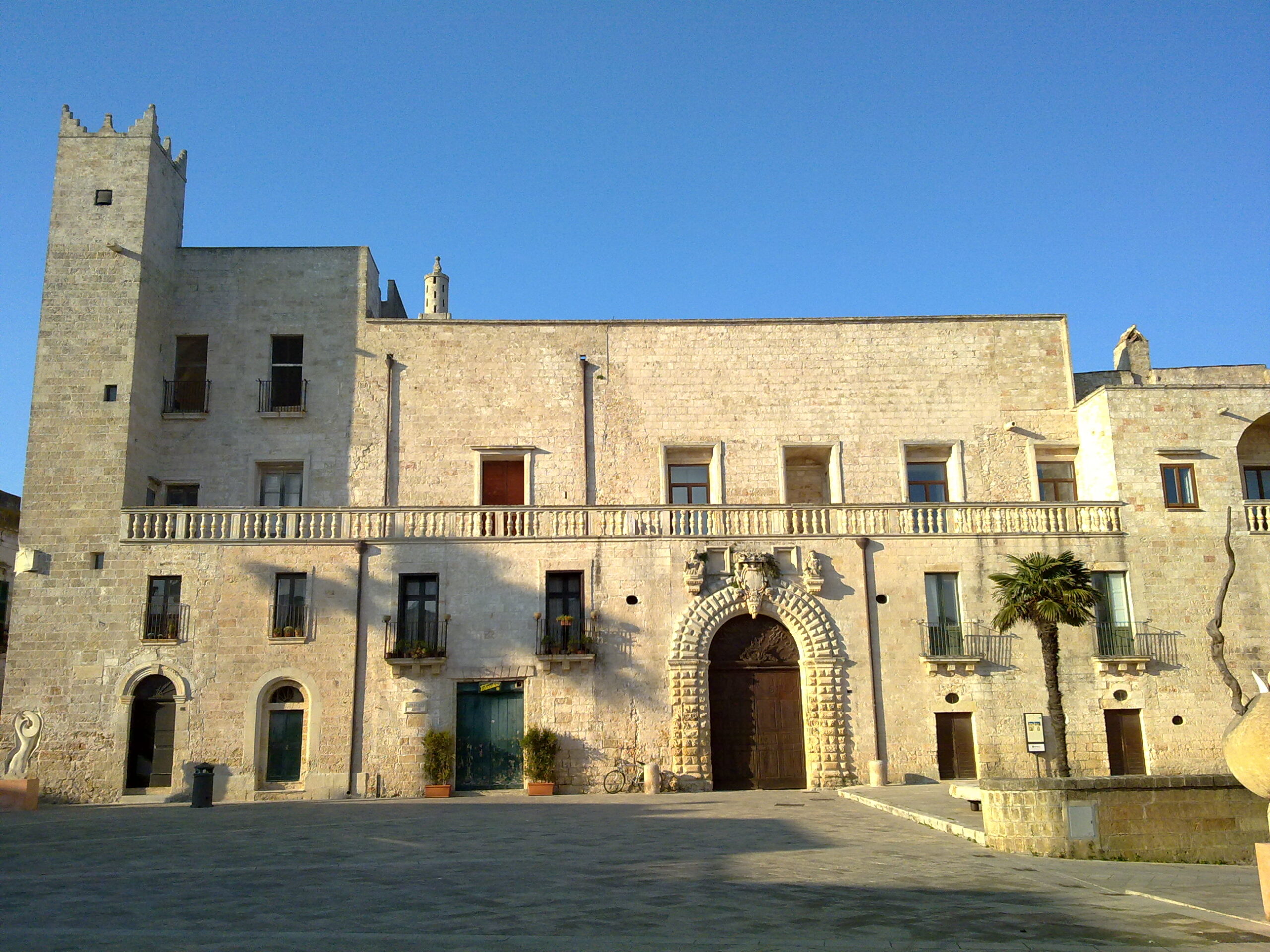
SPECCHIA
The name of the town derives from the Latin specula, an artificially raised place. In fact, it originates from the specchie, conical-shaped stone heaps that the Messapi used as a lookout and defense point or as a territorial demarcation system. In some documents up to the 18th century the name of Specla Presbiterorum is reported and hence Specchia Preti as it is currently called.
Specchia hosts a unique castle and monumental palaces: Castello Risolo, Palazzo Balsamo, Palazzo Ripa all concentrated in the center of the town where it stands an imposing square and where it is nice to spend some time admiring the nearby buildings, the beauties of the past.
SAN CASSIANO AND THE PADULI PARK
The Parco dei Paduli, so called due to the ancient presence of marshy areas, is an immense secular olive grove of about 5500 hectares wedged in the Mediterranean between the Adriatic and the Ionian seas and crossed by the ancient < strong>isthmic road which connects the ports of Gallipoli and Otranto, whose central nucleus extends into what are called Terre di Mezzo.
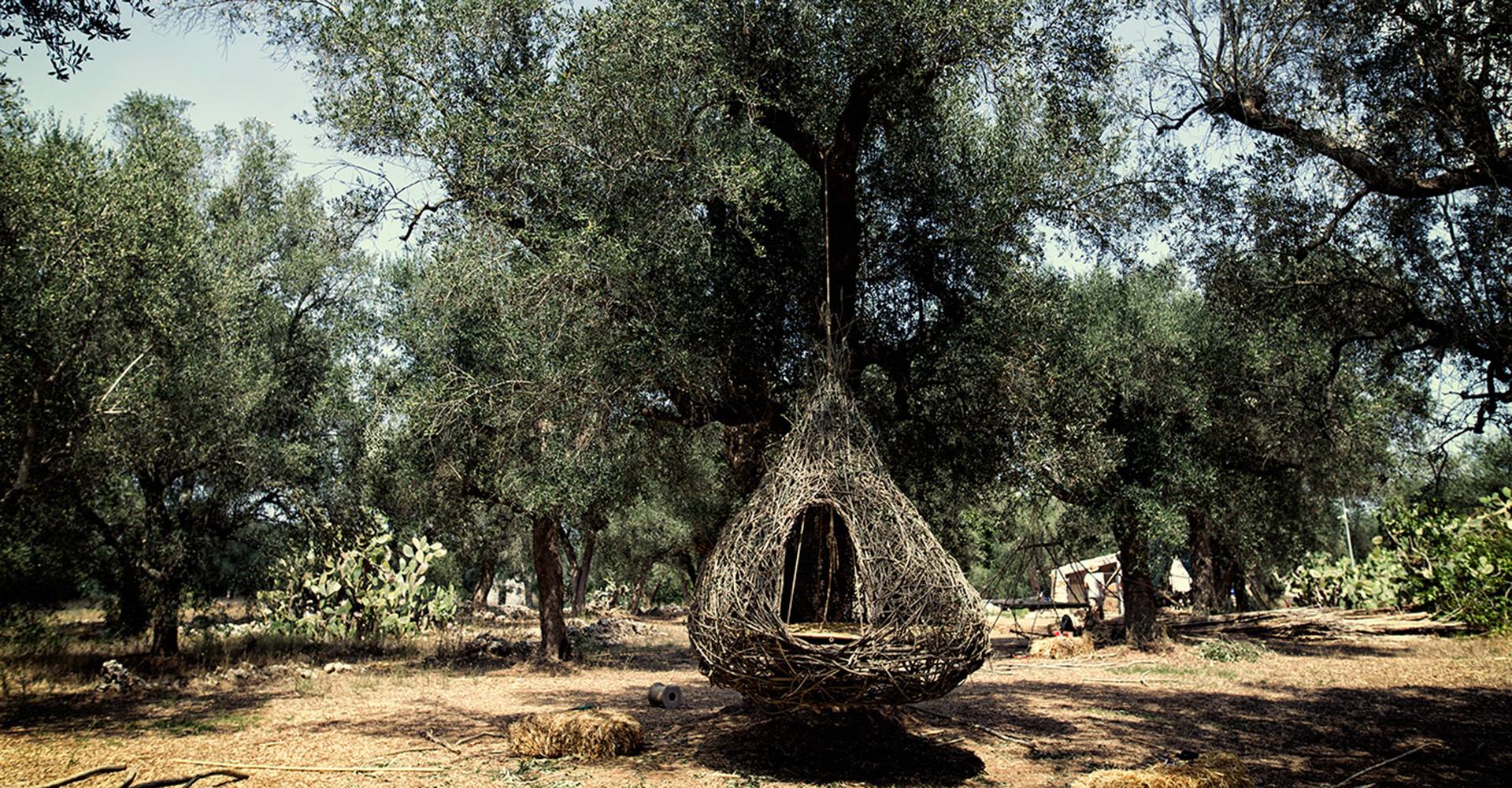
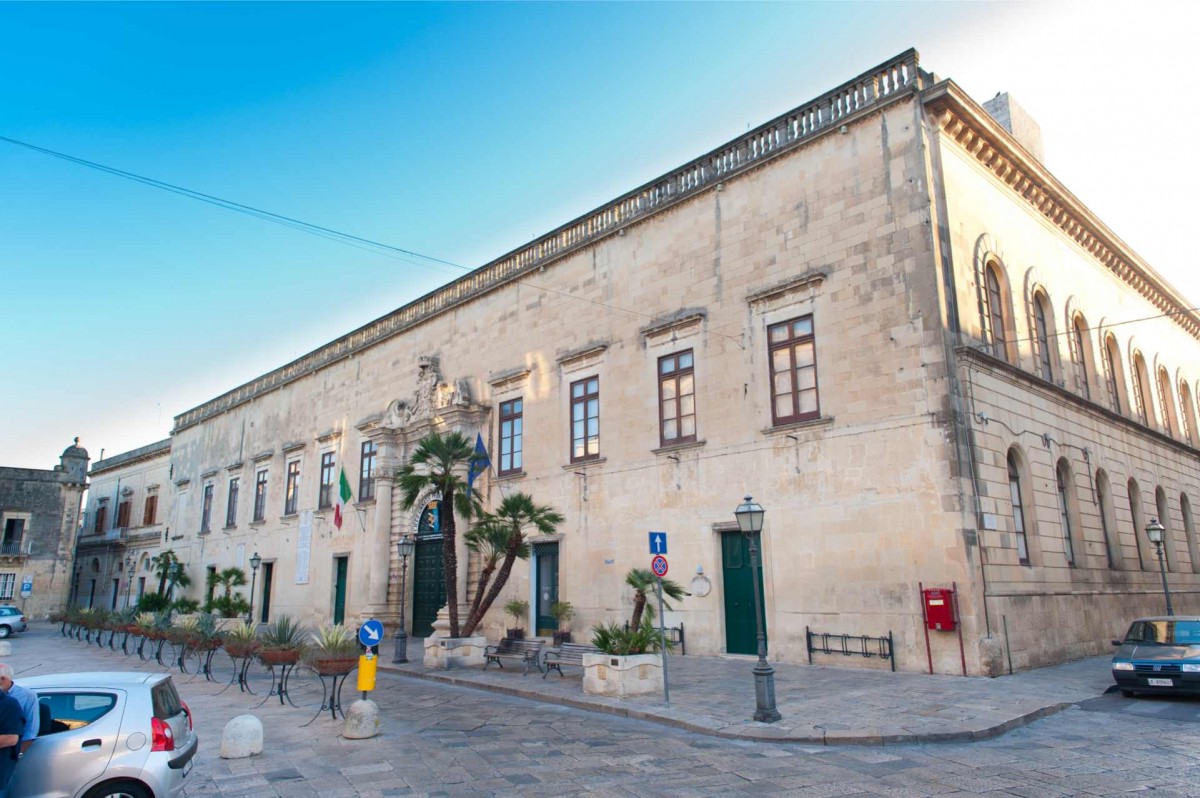
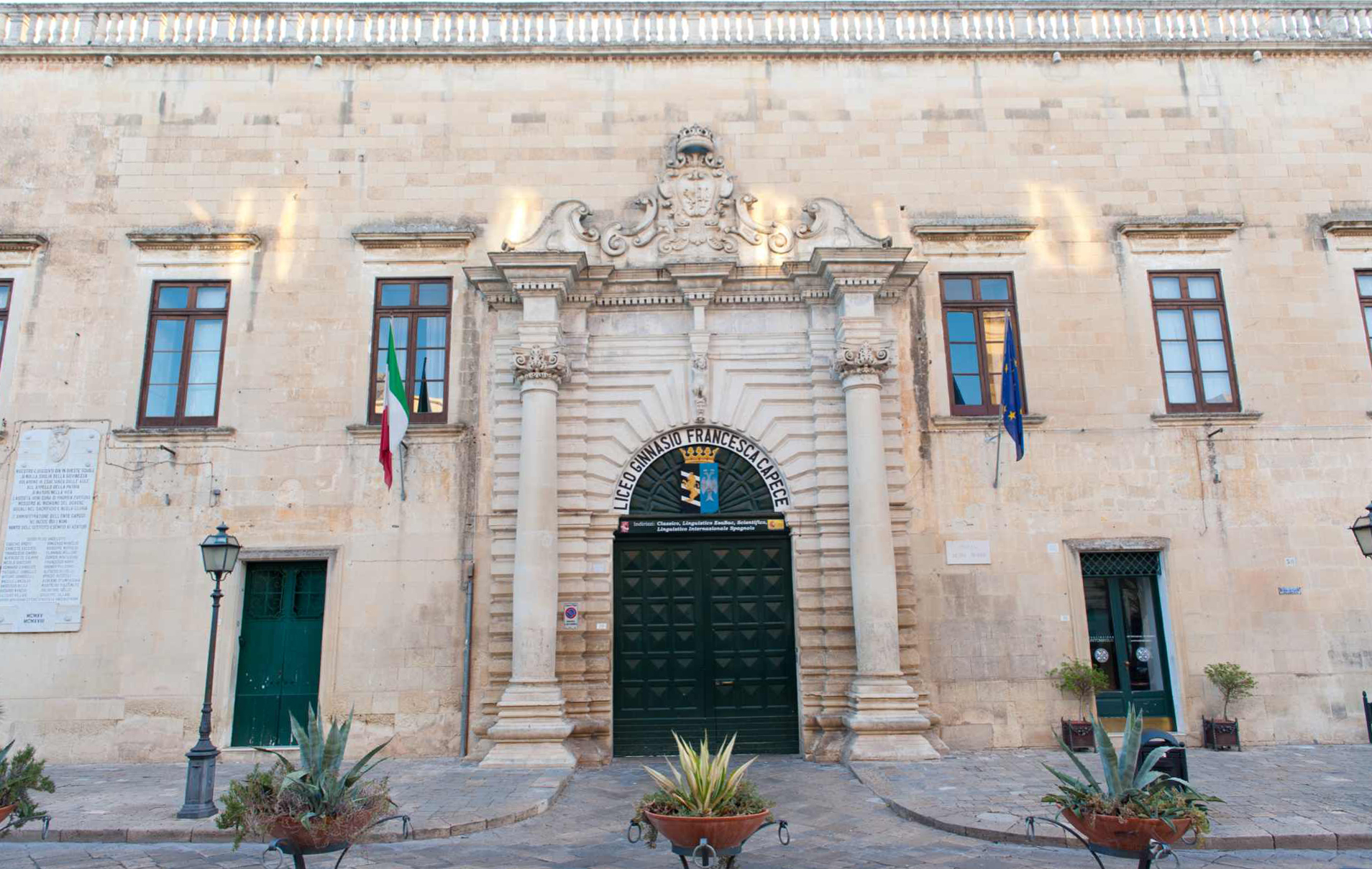
MAGLIE
Inhabited since the Bronze Age, the first inhabitants were presumably descendants of the Eneolithic and Neolithic populations capable of cultivating, breeding, building villages and erecting specchie, dolmens and menhirs). The area is home to numerous evidence of the megalithic (in the Policarita district, stands the dolmen with archaic characteristics called “Chianca” and other dolmens are: the two “Caramauli” in the locality of the same name, “Canali” in Muntarrune piccinnu, “Grotta“, “Pino ” and “Specchia” in San Sidero.
Similarly, menhirs abound: “Calamauri“, “Crocemuzza” (or “Franite”) and “Sprunu“. The most important evidence of human presence on site is the deposit of artifacts in the Cattìe fund discovered in 1980: about 12,000 tools and splinters and 800 bone finds (including a fossil human phalanx, probably belonging to a Neanderthal man).
Between the 13th and 19th centuries, the Maglie farmhouse began to develop around the Castle, which housed the first feudal lords of the area. The manor was presumably built at the time of the Angevins and subsequently reinforced and restructured by Andriolo Lubello (who was baron of Maglie under the reign of Alfonso I of Aragon).
The manor of Maglie remained practically unchanged for centuries until Don Ascanio Filomarino, who had become the feudal lord of the place, decided to modernize and restructure it, building an elegant façade with harmonious proportions to replace the grave and austere bulk of the military fortress. This palace was then embellished with a Baroque-style portal, surmounted by the heraldic shield of the Capece, who succeeded the Filomarinos in possession of the farmhouse.
Historic villages
NEWS ON HISTORICAL PLACES CROSSED BY THE ITINERARY OF THE SALENTO TRAIL

PALMARIGGI
Village located practically in the middle of the Maglie – Otranto route, whose name is linked to the prodigious event that took place according to tradition after the Otranto capture by the Turks. The inhabitants of the house of San Nicola invoked the protection of the Madonna who appeared holding a palm tree, and following an army. The Turks, fearing that the army led by duke Alfonso of Aragon was about to arrive, moved away and the population was saved. In memory of the event, the town changed its name to Palmarice, then Palmaricce and finally Palmariggi, which means “You who hold the palm“, in honor of the Madonna.
Palmariggi is home to an imposing Aragonese Castle built around 1480 following the capture of Otranto by the Turks, and was part of a vast strategic ring defense system, to protect Otranto itself, the capital of the province of the same name. It was Alfonso of Aragon who ordered the construction of the castle on the remains of the ancient Fortino di San Nicola, around which the village of Palmariggi would have formed around 1330. Only two mighty and massive cylindrical towers remain today of the structure, separated externally by a string course and joined together by a semi-ruined curtain wall.
Moreover, it is known for the festival that occurs every second weekend in October: «I paniri te e site» where the pomegranate and its exclusive uses are celebrated.

MASSERIA TORCITO
The Torcito-Cerceto farm in the 12th century was a large village inhabited by farmers dedicated to agriculture and sheep farming and then returned at the beginning of the 16th century, due to the growing danger of Turkish attack, in the coastal defense plan wanted by Carlo V by ordering and implementing the improvement of coastal defense systems. The Masseria di Torcito, resting on a slight plateau, a few kilometers from the sea, was highly exposed to the danger of Turkish attack, but at the same time constituted a good lookout point. But the history of the Torcito farmhouse is not only this but also that of its people who lived there and the time that marked its stones and you just need to take a walk between its walls and its carriageways to relive it.

TORRE DELL’ORSO
Torre dell’Orso is a seaside resort in Salento, marina of Melendugno.
Known for its beach of very fine silver-colored sand, Torre dell’Orso boasts a particularly clear sea due to the currents of the Otranto canal. The name of the locality derives from the presence, on the coast, of a 16th century tower used in the past to sight Turkish ships bound for Salento.
Torre dell’Orso is also known to most as the site of two stacks located about a hundred meters from the shore. Legend has it that two sisters, two local peasant women, one day approached the sea to cool off. One of the two entering the water is dragged away by the currents and gasps and screams for help: her sister can only throw herself to help her. In an attempt to reunite, they consume all their strength and embrace for the last time, now unable to overcome the fury of the sea, which swallows and drowns them.
However, the god of the sea is sorry, he has compassion for the two innocent sisters, one who died of unconsciousness and the other of brotherly love; so he transforms them into two stacks, close together for eternity.


OTRANTO
The city of Otranto is the easternmost Italian municipality in Italy, it is now known internationally for tourism and accommodation thanks to its coasts and intense blue sea. Historically Otranto is also sadly famous for the Turkish occupation of 1480 and for the trail of blood they left there.
On July 28, 1480, 18,000 Ottomans, with a fleet of 150 ships, moved towards the Salento town with the intention of sacking and conquering it. After an exhausting resistance by the inhabitants of Otranto who did not want to surrender, the Turks took possession of the village, committing all sorts of cruelties. 800 brave men, now saints, after refusing to convert to Islam, were beheaded on the hill of Minerva.
The Saracens remained in the city for a year, until the Aragonese entered the town and liberated it. But Otranto now retained very little of its old charm. The abbey of Casole had been destroyed, as well as commerce and the Cathedral. A reconstruction was urgently needed and the Aragonese were immediately aware of it. They immediately set to work, putting the Cathedral and the walls back on their feet. The convents of the Dominicans, of San Francesco and of the observers were rebuilt and, at the end of the 14th century, that of the Capuchins.
Otranto is also home to the Cathedral mosaic floor that the monk Pantaleone, belonging to San Nicola di Casole, executed on commission from the Bishop of Otranto, between 1163 and the 1165. which represents one of the most important mosaic cycles of the Italian Middle Ages. An extraordinary and grandiose work, animated by a sense of horror vacui due to the compositional flair that runs through it, and has been compared to an encyclopedia of images of the time and culture of the Middle Ages. It does not seem to find equivalents, in terms of complexity and level of elaboration, with other contemporary mosaics.

BAUXITE LAKE – BAY OF ORTE
Near the baia delle Orte, located a few kilometers south of Otranto along the coast road that leads to Santa Maria di Leuca, there is a very characteristic and well-known lake, which it originates in a former bauxite quarry now abandoned, which has given the water an intense emerald colour, rich in shades of great beauty. We are also near the Punta Palascia lighthouse, a sign that we are in the easternmost point of all of Italy.

MASSERIA CIPPANO
Masseria Cippano became an integral part of that defensive system wanted by the then emperor of the Holy Roman Empire, Charles V, in direct communication with Torre Sant’Emiliano >, from which to receive and forward the danger message in the innermost areas of the hinterland.
Equipped with a tower (about 15 meters high) organized on two floors, enriched by a staircase with a drawbridge. A fortified structure equipped with machicolations, enclosed by rampart walls and supplied with water by a system of cisterns capable of collecting, filtering and transporting the precious liquid to the various rooms. A place of work and war, of life against the cruelty of the Turks. Ozpetek’s film Mine vaganti was filmed here.

PORTO BADISCO
Porto Badisco is a pearl of rare scenic beauty. A crystal clear sea invites you to swim in every month of the year and the bar «da Carlo» with its prominent square will not fail to cheer you up in the sunny hours. Following the coast road to the south, you come across Torre Minervino a Saracen tower These are the coastal towers, the legacy of a fortification plan commissioned by Charles V in the 16th century to defend the southern coasts from the bloody invasions of Turkish raiders who arrived from the sea. Indeed, from the sea came the danger to be averted with the cry of “mamma… the Turks“.
In Porto Badisco there is also the Grotta dei Cervi, which contains important drawings made with bat guano dating back to the Neolithic and is characterized by numerous ravines and coves of rare beauty. Furthermore, in the direction of Santa Cesarea-Castro-Leuca, there is the so-called “Grotta delle Striare“, i.e. cave of the witches, characterized by the entrance crossed diagonally by a tongue of rock.

SANTA CESAREA TERME
Santa Cisaria in Salento dialect, until 1929 called Santa Cesarea is a municipality of 2,869 inhabitants. It is one of the centers with the greatest tourist vocation in Salento. It is a hydrothermal station. The exploitation of sulphurous waters and thermal mud dates back to the 2nd century BC. The healing waters flow from four caves: the Gattulla, the Solfatara, the Solfurea and the Fetida.
The pagan myth connects the genesis of the sulphurous waters to the disintegration of the bodies of the Leuterni giants, killed by Heracles. The Christian version instead wants Cesarea, or Cisaria, to be a girl with an early vocation to the monastic life. That to escape the repeated incestuous intentions of her father, she hid in a cave where she was saved from the flames that enveloped her father, then swallowed by the sea.
Santa Cesarea Terme is also known for the beauty of its Villas. Among these the Palazzo Sticchi and the Villa Raffaella

CASTRO
Castro is located along the eastern coast of the Salento peninsula, the municipality is made up of the main town of medieval origin, located on a promontory at 98 m above sea level. (Casciu de susu), and from the lower part of Castro Marina (Casciu de sutta), built around the port. Fishing and seaside resort, it boasts ancient origins as the heir of the Roman Castrum Minervae. Castro as well as for its splendid sea (characterized by a high quantity of fresh water springs) is also known for its splendid Aragonese Castle, considered one of the most important castles in all of Puglia.

TRICASE AND THE SERRA DEL MITO
The origin of the name is still uncertain and the subject of studies and research. There are those who attribute its origin to the union of three different farmhouses which, by uniting, would have given rise to a single residential nucleus. Another more accredited theory translates its name as inter casas, that is to say, a town formed in the midst of other hamlets. But there are also those who attribute to it an entymology deriving from the Greek and therefore thesis, tracing its genesis back to Demetrios Tricás, a young official of the Eastern Roman Empire, in charge to monitor the situation of Capo di Leuca.
Among the noteworthy natural and historical architectural beauties, the following certainly stand out: The Palazzo Gallone, The Vallone Oak, dating back more than 900 years ago and the Torre del Sasso , ancient remains of a coastal defense system against Saracen attacks.

SANCTUARY OF SANTA MARIA DI LEUCA “de finibus terrae“
The church stands on the ruins of a pagan temple dedicated to Minerva, as evidenced by the discovery of an altar, kept inside the church, on which was written: “Ubi olim Minervae sacrificea offerebantur hodie oblationes Deiparae recipiuntur ” (Here where sacrifices and gifts are offered to Minerva, sacred offering to Maria Cristian you place)
Following the landing of the apostle Peter, of which the stone cross remains, the local population converted to Christianity. The church boasted a painting of the Virgin which was believed to be the work of San Luca which however was lost in its destruction following the edict of Diocletian and Galerius. Pope Julius I a few years later ordered its reconstruction anyway (the year was 343 as reported on a plaque: «Julius hic primus celebrans, emmissa de coelo Indulta accepit. Kalendas, CCCXLIII dum Consecravit hoc templum”
Over the years the church was repeatedly destroyed or looted by the Saracens and the Turks, the various nefarious events are dated in 1507, 1537, 1550, 1624 and 1720, but it was always rebuilt and fortified. During John Paul II’s visit in 1990, it was raised to a minor basilica, while another papal visit took place in 2008 with Benedict XVI.

SPECCHIA
The name of the town derives from the Latin specula, an artificially raised place. In fact, it originates from the specchie, conical-shaped stone heaps that the Messapi used as a lookout and defense point or as a territorial demarcation system. In some documents up to the 18th century the name of Specla Presbiterorum is reported and hence Specchia Preti as it is currently called.
Specchia hosts a unique castle and monumental palaces: Castello Risolo, Palazzo Balsamo, Palazzo Ripa all concentrated in the center of the town where it stands an imposing square and where it is nice to spend some time admiring the nearby buildings, the beauties of the past.

SAN CASSIANO AND THE PADULI PARK
The Parco dei Paduli, so called due to the ancient presence of marshy areas, is an immense secular olive grove of about 5500 hectares wedged in the Mediterranean between the Adriatic and the Ionian seas and crossed by the ancient < strong>isthmic road which connects the ports of Gallipoli and Otranto, whose central nucleus extends into what are called Terre di Mezzo.


MAGLIE
Inhabited since the Bronze Age, the first inhabitants were presumably descendants of the Eneolithic and Neolithic populations capable of cultivating, breeding, building villages and erecting specchie, dolmens and menhirs). The area is home to numerous evidence of the megalithic (in the Policarita district, stands the dolmen with archaic characteristics called “Chianca” and other dolmens are: the two “Caramauli” in the locality of the same name, “Canali” in Muntarrune piccinnu, “Grotta“, “Pino ” and “Specchia” in San Sidero.
Similarly, menhirs abound: “Calamauri“, “Crocemuzza” (or “Franite”) and “Sprunu“. The most important evidence of human presence on site is the deposit of artifacts in the Cattìe fund discovered in 1980: about 12,000 tools and splinters and 800 bone finds (including a fossil human phalanx, probably belonging to a Neanderthal man).
Between the 13th and 19th centuries, the Maglie farmhouse began to develop around the Castle, which housed the first feudal lords of the area. The manor was presumably built at the time of the Angevins and subsequently reinforced and restructured by Andriolo Lubello (who was baron of Maglie under the reign of Alfonso I of Aragon).
The manor of Maglie remained practically unchanged for centuries until Don Ascanio Filomarino, who had become the feudal lord of the place, decided to modernize and restructure it, building an elegant façade with harmonious proportions to replace the grave and austere bulk of the military fortress. This palace was then embellished with a Baroque-style portal, surmounted by the heraldic shield of the Capece, who succeeded the Filomarinos in possession of the farmhouse.

